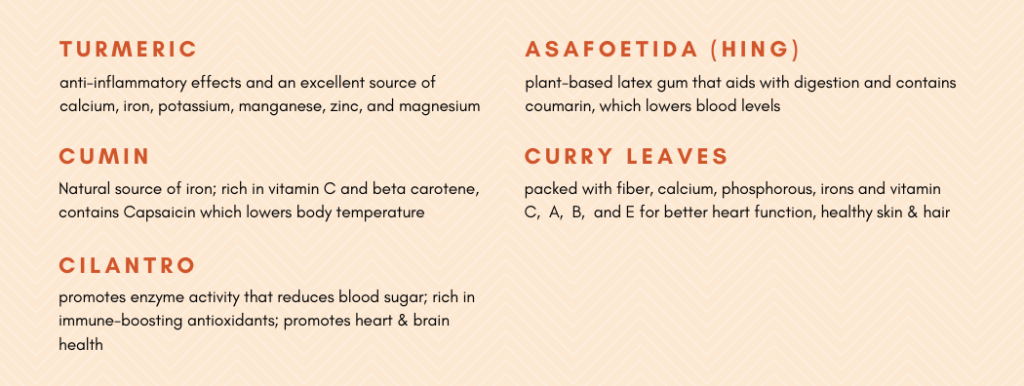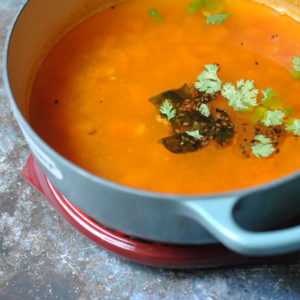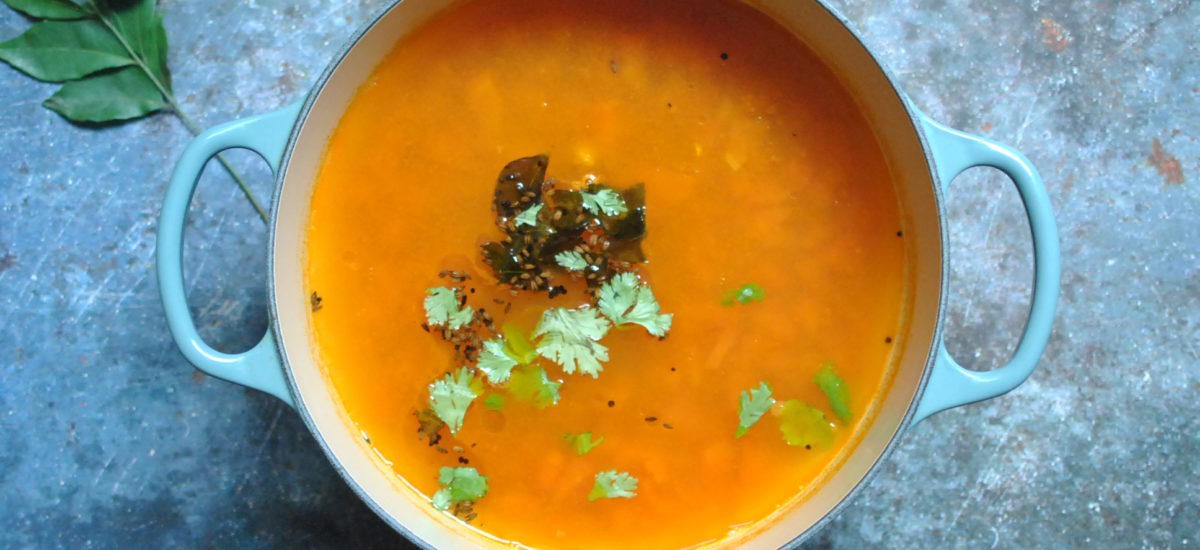In sickness and health, I’m eating Tomato Rasam.
What my Jewish friends growing up experienced with matzah ball soup, I experienced with rasam — warmth, comfort, and fulfillment. South Indian Tomato Rasam (Tomato Lentil Soup) is a tangy and exceptionally tasty staple in made with lentils, tomatoes, spices herbs. Rasam boasts a repository of flavors that are so unique and distinct, that if I smell rasam from miles away, I am instantly transported home. In fact, pre-quarantine I was enjoying a delightful lunch at Chennai Garden in Flatiron, Manhattan and nearly teared up when my waiter brought me a cup of rasam (on the house!) on top of the sizeable meal I had just ordered. Somehow, he looked at me, and he knew.
Rasam has the consistency of soup, but is typically eaten over a bed of rice with heaping servings of vegetables. It’s usually poured over rice and eaten with cooked vegetables. There are many variations and types of rasam, but this is my mom’s recipe for tomato rasam – what I grew up on.
During a recent bout of sinus headaches and homesickness, I called my mom for specific instructions on making rasam. I went right to work in the kitchen, with hopes that I would make enough rasam for the week. I started on this expedition feeling like I was completely killing the game, providing for myself in a time of need. About 20 minutes into cooking, I triggered the fire alarm from overheating the mustard seeds, much to the frustration of my neighbors. Yikes – I guess I do still need my mom. I honestly think she started this blog as an answer to my cry (alarm) for help. It’s working!
Slurp alert: a couple notes
Even on hot summer days, I wouldn’t pass on this soup.
It has so many therapeutic properties. Here’s what you’ll find in one bowl of this elixir: thiamin, folic acid, vitamins A & C, niacin, potassium, iron, calcium, zinc, selenium, copper & magnesium
Hello amazing skin, healthy digestion, heaps of protein, and bouts of energy!
This recipe calls for asafoetida.
You can’t find it at Whole Foods, and you’ve probably never heard of it if you are new to South Asian cooking. The smell is slightly pungent, but once it touches the saucepan, it transforms your food. In Indian cooking, asafoetida is a very common flavor enhancer, that can magnify the rich smell and taste of spices and herbs. It is basically a gum extracted from the ferula plant of the celery family. You might also see it referred to as hing in other recipes. I use the brand “L.G.”, one of the more popular brands of asafoetida (so popular, I’ve heard my aunts refer to asafoetida as “L.G.” as if we all know should know what she’s referring to. Almost akin to calling every soda a “Coke”).
You can find asafoetida at your local Indian store or here on Amazon.
The seasoning completes the dish: don’t skip it!
No rasam is complete without the seasoning, which is a tempered medley of spices. Tempering, very commonly referred to as tadka throughout India, completes many dishes, and this is one of them. In a separate saucepan or skillet, heat ghee and once it starts to warm up, throw in one or two mustard seeds to see if they start to sizzle. If you hear a sizzle, throw the rest of the mustard seeds in and immediately cover the pan with a lid, or else the mustard seeds will crackle and pop to every end of your kitchen. When you hear the popping start to subside, add the rest of the ingredients, stir quickly, and turn off the heat. Your tadka is ready and should go directly in your cooked rasam. Be careful of overheating the ghee and mustard seeds. It’s important to get the temperature right at first so the spices have a chance to breathe and become their best selves.
Our rasam calls for tur dal (split pigeon peas)
Tur dal, or yellow split pigeon peas, is super rich in fiber and protein. I usually cook it in my pressure cooker, but you can absolutely make it on the stovetop. If you are making dal for this recipe only, I would suggest following our stovetop recipe! Make sure you soak the uncooked dal in water for at least an hour before you start cooking it.
As I mentioned, there is a variety of types of rasam, and a multitude of ways to cook it. When it comes to tomato rasam in our house, this is what we’re doing. Drop any comments or questions below! We’d love to help you bring rasam to your kitchen table and help in any way we can!
History
According to some other historical sources, the origin of rasam is in Madurai and it dates back to the 16th century. It is said to have been discovered during ancient times, when a ruling king’s son fell ill. A local commoner gathered indigenous ingredients – such as lemon, curry leaves, gooseberries, black pepper, and turmeric – and invented this aromatic, hearty soup that cured the king’s son and became a hit. Rasam then found it’s way to royal kitchens and into the narrative of Indian history.
Rasam, when translated literally from Tamil, means ‘juice’. It can refer to any juice, but in South Indian households this word usually refers to the tomato rasam. It grew so popular that during the British occupation of India, British soldiers adapted it to a dish known as ‘Mulligatawny Soup’ – which translated from Tamil means ‘pepper water’.
Spice Mix

And a final note… We are always looking for ways to decolonize our spice rack.
If you are need of any of the spices for this recipe or others, we encourage you to shop at Diaspora Co. for all your Indian spice pantry needs! We do our shopping in local food stores and Whole Foods alike, but where our food comes from is meaningful to us. Diaspora Co prioritizes the support of local farmers, who are at the cutting edge of regenerative and sustainable agriculture. Consider supporting them and similar businesses!
Until then…
Stay Cumin.

Tomato Rasam
Equipment
- Instant Pot (optional)
- Stockpot
- Cutting Board
- Knife
Ingredients
Rasam
- Tomato – 3 medium size
- Rasam Powder – 3 heaped tsp
- Turmeric – 1/4 tsp
- Asafoetida – 1/4 tsp
- Cooked tur dal – 1 cup
- Curry leaves – 4 to 5
- Lemon juice – 1 tablespoon
- Salt as needed
Seasoning
- Ghee – 2 tsp *
- Mustard seeds – 1/2 tsp
- Cumin seeds – 1/2 tsp
- Curry leaves – 4 to 5
- Cilantro chopped – 1/2 cup
Instructions
Rasam
- Finely chop the tomatoes and add to a saucepan with 2 cups of water
- Bring to a boil until tomatoes are soft. Optional step: for a smoother consistency, blend the softened tomatoes with a hand-blender or food processor. Add back to the pot.
- Add the salt, rasam powder, turmeric, and asafoetida.
- Cook on a low flame for roughly 4 to 5 minutes, until it begins to bubble up
- Mash the cooked dal and mix into the rasam.
- Add approximately 1 1/2 to 2 cups of water, until you have a watery and thin consistency.
- Cook on a low flame. When the rasam begins to froth, turn off the flame. Make sure the rasam does not boil.
- Add lemon juice and stir.
Seasoning (Tadka)
- Heat ghee in a small fry pan. Add mustard seeds and close the pan with a lid. Turn the flame to low.
- The mustard seeds will start to splutter. Once the mustard seeds stop spluttering, turn off the flame.
- Add cumin seeds, and once they begin to sizzle, add curry leaves. Immediately pour the seasoning over the rasam.
- Garnish with chopped cilantro and serve.



1 thought on “South Indian Tomato Rasam (Tomato Lentil Soup)”